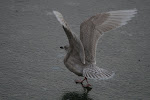Since January 29th, I have ringed 781 new birds of 65 species (processed 844 birds of 66 species (I've not yet actually ringed Mute Swan despite 17 retraps!))
Oh the species I have ringed, a few stick out in my mind as being species that I never thought I'd ever ring!
In addition to the unexpected birds, I have added to the experience of ringing by visiting some rather unusual ringing locations
 26th March saw Chris and I cannon-netting gulls on a Landfill site catching 138 birds. Everything about this location was surreal including the bouncy floor that made running to the net a somewhat comical experience!
26th March saw Chris and I cannon-netting gulls on a Landfill site catching 138 birds. Everything about this location was surreal including the bouncy floor that made running to the net a somewhat comical experience! Catching 31 Pied Wagtails outside the entrance of Tesco car park in Bangor was also very surreal as it was still rather busy with the petrol station still being open and car passing by all the time.
Catching 31 Pied Wagtails outside the entrance of Tesco car park in Bangor was also very surreal as it was still rather busy with the petrol station still being open and car passing by all the time.The Tubenose Challenge hasn't really had the kick start it needs yet, so it was an apt way to finish the six months with a trip to catch Manx Shearwater and European Storm-petrel. This went down as the best ringing session of the lot as Manx Shearwater has been a species close to my heart pretty much since I read my first bird book back in 1998.
 European Storm-petrel and Manx Shearwater were the 2nd and 3rd species to be photographed for the Tubenose Challenge after we retrapped an adult Fulmar on our first trip to Puffin Island. This is another species that I adore and can't believe how lucky I am to have held such a superb bird!
European Storm-petrel and Manx Shearwater were the 2nd and 3rd species to be photographed for the Tubenose Challenge after we retrapped an adult Fulmar on our first trip to Puffin Island. This is another species that I adore and can't believe how lucky I am to have held such a superb bird! I think it would be unfair to not give a few thanks to people for helping me in my first 6 months. A big thanks for Steve Dodd and Rachel Taylor for being my official trainers when I am ringing in North Wales. I doubt I would be where I am now without your help. Kane Brides is my adopted trainer for when I venture into the North West. I certainly wouldn't be where I am today in terms of progression with ringing if it wasn't for Kane as he has the advantage of being my mate as well as my part-time trainer so he knows where I am struggling and how to overcome any problems I may have. I have also met many other people that have provided me with memories that will last a lifetime
I think it would be unfair to not give a few thanks to people for helping me in my first 6 months. A big thanks for Steve Dodd and Rachel Taylor for being my official trainers when I am ringing in North Wales. I doubt I would be where I am now without your help. Kane Brides is my adopted trainer for when I venture into the North West. I certainly wouldn't be where I am today in terms of progression with ringing if it wasn't for Kane as he has the advantage of being my mate as well as my part-time trainer so he knows where I am struggling and how to overcome any problems I may have. I have also met many other people that have provided me with memories that will last a lifetimeNo thank you would be complete without thanking Chris 'the birdman' Bridge who pushed me to start ringing in the first place and has introduced me to some superb people who will only be assets to know in future life.
 ...Lets hope for a similarly incredible 6 months when I get to a year into my training!
...Lets hope for a similarly incredible 6 months when I get to a year into my training!










































 This was my first visit to the colony and I was not expecting to ring so many birds! Between the 5 of us, we ringed 477 birds in 2 hours, which is incredible! It was an incredibly enjoying, albeit tiring, trip which was rounded off by catching another adult at the services to 'show off' our catching technique to Aiden whom had never previously ringed adult Black-headed Gulls.
This was my first visit to the colony and I was not expecting to ring so many birds! Between the 5 of us, we ringed 477 birds in 2 hours, which is incredible! It was an incredibly enjoying, albeit tiring, trip which was rounded off by catching another adult at the services to 'show off' our catching technique to Aiden whom had never previously ringed adult Black-headed Gulls.







